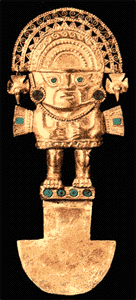
The worship of these deities constituted a daily enterprise, with peasants paying homage to their household god, or Waca, as priests honored the gods of sun, moon, and earth. A priestly class, exalted among the ranks of Incan society, operated on a strict heirarchy. Leading a purely religious lifestyle, they served as media between man and the gods, carrying out their respective duties in temples speckling the empire. Cuzco, acknowledged by the Inca as the center of the universe, was the seat of the most revered temples, with the high priest presiding over Coricancha, the most sacred temple of Apu Inti.
Incan relgion was thoroughly idolatrous, with all gods being represented by an appropriate talisman. Golden disk figures of the sun god (Apu Inti), silver crescent figures of the moon god (Mamaquilla), and feline statues of the creator (Viracocha) are but a few examples of the customary idol forms. Prophecy and sorcery were also commonplace, with healings and fortune telling traditionally practiced by the local priests.
The Incans viewed death as a rite of passage to an afterlife, with postmortem paths diverging to an upper and alower heaven (kaypacha and ukupacha, respectively). These divisions of the spirit world reflect the common Andean dichotomy between hanan and hurin, or upper and lower. Unhappy ghosts that returned to interfere in the daily lives of their family were thought to reside in the lower, while spirits resting in the celestial kingdom of the gods were resting peacefully.